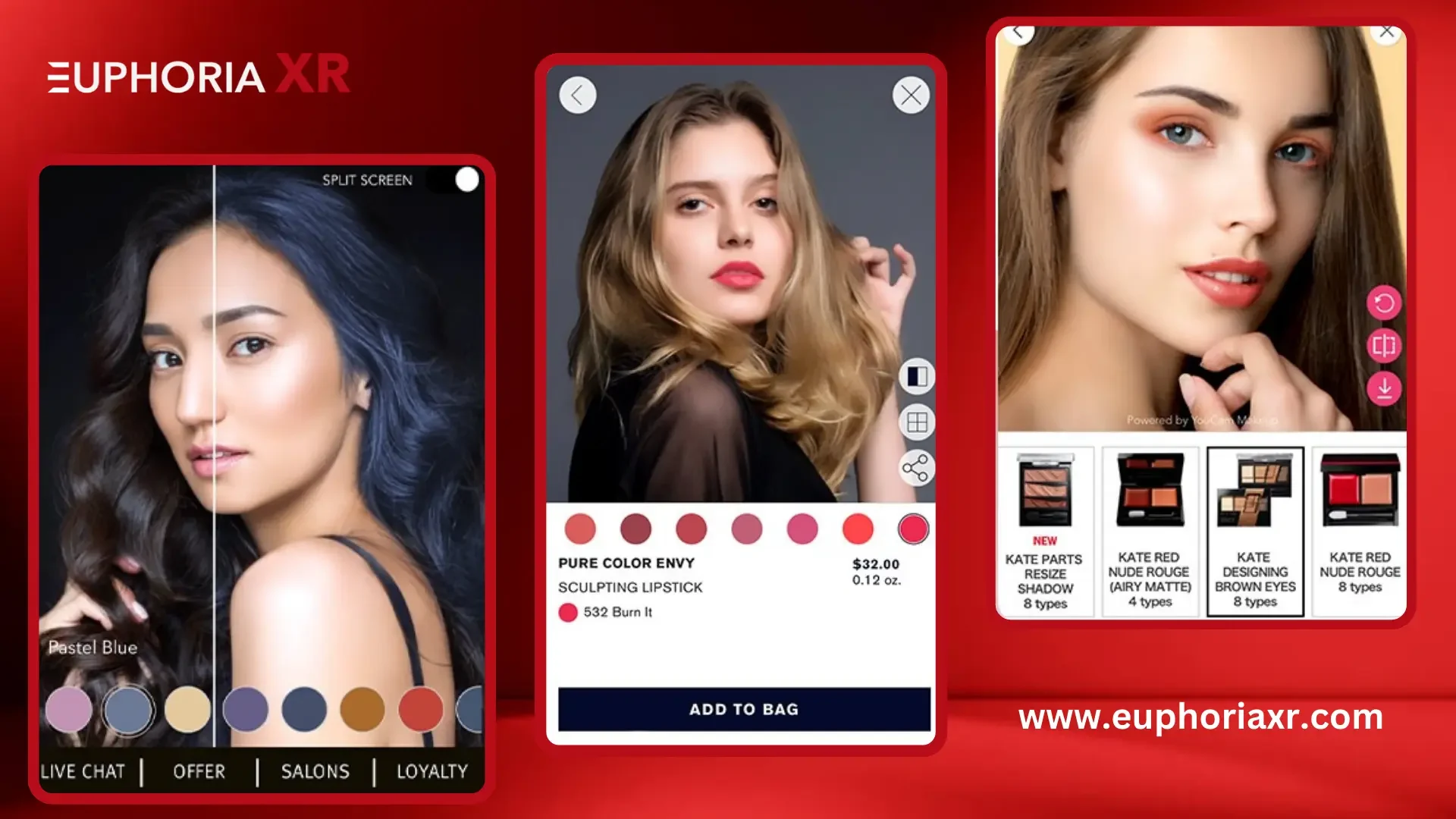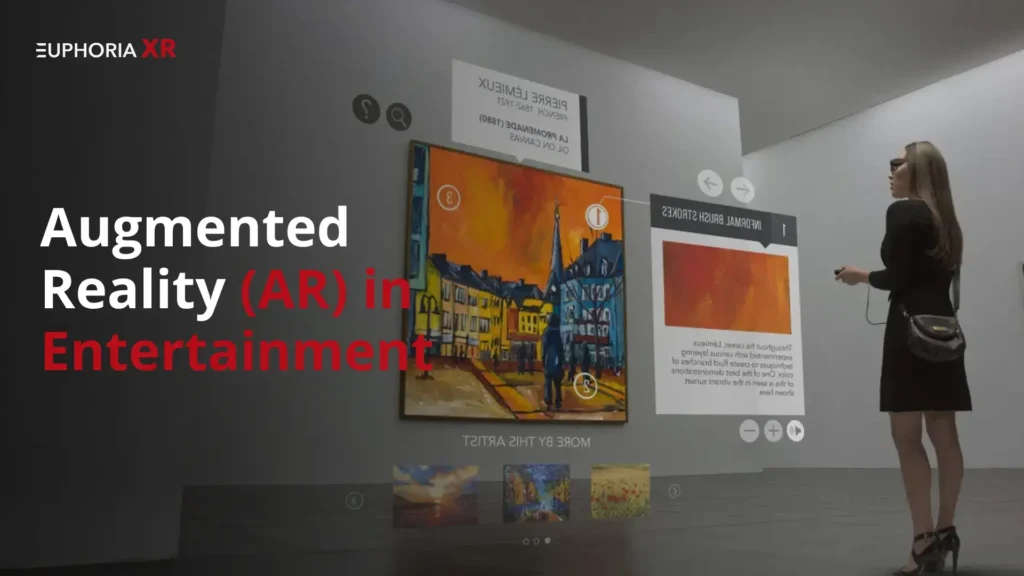The beauty industry is transforming with the launch of AR beauty filters. According to market projections, the global application of AR and VR in the cosmetics and beauty markets is set to expand at a staggering compound annual growth rate (CAGR) of 25.5% from 2022 to 2027. This rapid growth underscores the significant impact of AR beauty filter apps and related technologies on the industry.
From virtual makeup try-ons and personalized skincare analysis to customized shopping experiences and engaging DOOH (Digital Out-of-Home) advertising campaigns, cosmetics brands use AR filters to attract and serve customers more effectively than ever. This guide will examine the historical connection between technological advancement and the beauty industry and discuss how brands are currently integrating AR Filters into services and marketing.
Key Benefits of AR Beauty Filters
1. Increased Personalization and Customer Satisfaction
Augmented reality enables beauty brands to offer highly personalized shopping experiences. Through AR face filter apps, customers can engage in virtual consultations, receive complexion analyses, and discover personalized skincare regimes. This level of customization brings customers closer to products that suit their specific needs, reducing dissatisfaction and enhancing overall satisfaction.
2. Revolutionizing Marketing Strategies
AR beauty filter apps allow beauty brands to elevate their marketing strategies by creating distinctive DOOH campaigns, offering virtual search capabilities, and even virtual fragrance experiences. These innovative approaches enable brands to engage consumers through memorable multi-channel interactions–increasing brand visibility and customer engagement.
3. Connecting with Digital Natives
As digitally native generations like Millennials and Gen Z occupy an ever-larger slice of the consumer market, brands must meet them where they are. Partnering with an Augmented Reality development company can help brands utilize the latest technologies and bring their AR visions to life. With Euphoria XR, brands can address the expectations and concerns of these tech-savvy consumers by providing immersive and interactive experiences that resonate with their preferences.
4. Supporting Sustainability Efforts
AR tools can play a major role in advancing sustainability within the cosmetic industry. By enabling virtual try-ons and reducing the need for physical samples, AR helps reduce waste, lower costs, and appeal to eco-conscious consumers. This benefits the environment and allows brands to stand out in a saturated market.
The Symbiotic Relationship Between Technology and the Beauty Industry
The beauty industry has always been closely linked with technological advancements. Dating back to ancient times when alabaster face powder and Cleopatra’s kohl eyeliner were popular, the desire to enhance beauty has been a constant. However, it was the 20th century that saw a surge in the popularity of products we traditionally associate with the modern beauty industry—lipstick, mascara, nail polish—and this growth was fueled by technological innovation.
Historical Role of Technology in Beauty
Innovations such as portrait photography, the availability of affordable and compact mirrors, and especially motion pictures propelled the development and mainstream use of cosmetics. In the 1920s, the silver screen introduced audiences to glamorous movie stars, and people began using makeup to copy their favorite celebrities. Marketing quickly adapted to this trend, and the beauty industry flourished.
Technological innovation continued to popularize the industry throughout the decades. New formulas stabilized products for longer periods and made them safer to use. Advancements in media and marketing widened the pool of consumers, bringing beauty products to the masses.
The advent of social media in the 21st century further revolutionized the industry. Influencers and beauty bloggers gained immense popularity, democratizing new trends and beauty standards. Platforms like Instagram and YouTube gave a voice to demographics previously overlooked in marketing campaigns, shifting the industry towards a more inclusive approach.
Augmented reality filters are helping the beauty industry take another step forward.
As an AR Filters Development Company, we specialize in creating innovative AR filters that enhance customer interaction and engagement. Our experienced team has designed various AR filter apps for beauty, retail, and marketing campaigns, helping brands deliver immersive and memorable experiences. Whether it’s virtual try-ons or interactive advertising, our custom AR solutions are customized to meet your business needs.
Ready to create your AR filter?
The Emergence of Augmented Reality in the Beauty Sector
Brands are always looking for more compelling ways to engage customers, and as digital natives comprise an increasingly significant part of the consumer market, blending the digital and physical has become essential. Augmented reality isn’t new technology, but its popularity has surged in recent years, partly due to the disruption caused by the COVID-19 pandemic.
The rapid growth of eCommerce and diverse shopping channels has led to a shift in marketing approaches and a greater emphasis on digital innovation. Leading brands in the beauty industry are using augmented reality filters to deliver exceptional, customer-focused experiences— connecting with shoppers in unprecedented ways. AR technology overlays digital elements onto real-world images via tablets or smartphones, allowing virtual objects or animations to appear within the live camera view.
AR has revolutionized shopping by enabling personalized experiences, such as skin health assessments and precise shade-matching. This technology benefits both consumers and brands. For consumers, it provides tailored shopping experiences, while for brands, AR filter development helps boost profit margins by reducing product returns and enhancing inventory management.
Improving Customer Service with AR Beauty Filters
The unpredictability of online shopping is a common pain point for consumers when purchasing beauty and cosmetic products. Shoppers often gamble on whether a product suits their skin tone or complements their style. This uncertainty can prevent potential customers from making online purchases and increase the returns of those who do.
The cosmetics industry experiences a cart abandonment rate of 75%. Nonetheless, AR beauty filter apps assist customers in making more informed decisions and shopping with increased confidence. A survey of over 4,000 shoppers across the UK, US, France, and Saudi Arabia found that about two-thirds of those who used AR to guide their purchases were less likely to return products. Since returned cosmetics are often unsellable, reducing return rates helps cut down on waste and decreases shipping, labor, and unsold stock costs.
Augmented Reality Makeup Try-On Services
AR filter apps enable users to try out lipstick shades, eyeshadows, blushes, and false eyelashes using mobile devices. Users can adjust makeup intensity, switch between products, and save their favorite looks for future reference. These applications offer more than just virtual color applications; they provide a comprehensive virtual try-on experience.
For example, Burberry Beauty’s virtual studio experience combines facial tracking and AR technology to create highly realistic makeup simulations. The system accurately maps features by monitoring more than 100 facial points to provide precise virtual makeup applications. Users can refine their look with a personalized profile and access tutorials tailored to their unique facial features, such as eye shape and skin type. The AR tutorials include 3D animations overlaid on the user’s face, showing exactly where to apply makeup for various occasions.
Likewise, Sephora has implemented a 3D AR makeup mirror in its stores, allowing customers to sample cosmetic shades directly on their faces without physical testers. Customers can view shades from multiple angles by interacting with the Beauty Mirror’s on-screen palette, aiding in more accurate and hygienic product selection.
Virtual Hair Styling and Coloring
Augmented reality filters aren’t just for makeup; they have also proven to be a critical breakthrough for hair styling. Many people become anxious about cutting or coloring their hair due to the risk of not achieving the desired result. What if that bob doesn’t suit them, or the bubblegum pink hair dye isn’t flattering?
Thankfully, AR beauty filter apps enable users to visualize different haircuts and try various hair colors without making permanent changes. Users can test the look on an app before committing, whether it’s a sleek updo or a bold new color. These tools boost consumer confidence and increase brand engagement.
L’Oréal’s Hair Color Virtual Try-On is a mobile app that lets users experiment with different hair colors in a virtual setting. By uploading a photo or using real-time camera mode, users can instantly select a hair color and see the transformation. This interactive experience helps customers find the perfect shade without any risk.
Similarly, Garnier offers an online virtual try-on tool enabling customers to find their perfect shade. Users can upload photos or scan their faces before experimenting with different colors. Garnier also advises on the best shade for a person’s complexion using an accompanying Shade Selector Quiz.
Amazon’s hair salons feature a full in-store color bar where customers can virtually experiment with different hairstyles and colors before deciding on the look they want. The salon also displays a range of hair products that visitors can purchase, like shampoos and straighteners. Customers can scan a QR code next to the product to place their order and even view details such as ingredients, benefits, and instructions.
AR Beauty Filter Apps Enhance Skincare
Augmented reality (AR) beauty filter apps are transforming makeup experiences and making significant strides in skincare. These technologies can monitor skin health and provide personalized skincare recommendations. When users know they can revisit an app for follow-up analyses at any time, it gives the impression of having a personal dermatologist readily available—an appealing and distinctive brand selling point.
L’Oréal’s SkinConsult AI
L’Oréal’s SkinConsult AI is a digital skin diagnostic tool that personalizes anti-aging skincare solutions. Users upload a selfie, and the technology analyzes signs of aging, such as under-eye wrinkles, dark spots, loss of firmness, fine lines, and deep wrinkles. Users receive a customized skin aging matrix and product routine recommendations tailored to their needs based on the assessment.
Clinique’s Clinical Reality App
Similarly, Clinique’s Clinical Reality app offers a quick 30-second skin analysis. After taking a selfie, the app provides a personalized skin diagnosis, highlighting issues like dehydration, irritation, acne, fatigue, uneven texture, enlarged pores, lines, wrinkles, and loss of volume. The tool then suggests customized treatment options for each identified concern.
These innovative tools are game-changers for brands aiming to gain a competitive advantage and establish themselves as experts in their niche. More importantly, they build consumer confidence and loyalty, which leads to higher customer retention and repeat purchases.
Augmented Reality in Beauty Industry Marketing
AR filter development companies are assisting brands in revolutionizing their marketing and advertising strategies. With AR beauty filter apps and integrations, brands gain a better understanding of what consumers are seeking. By analyzing consumer behavior, purchase history, and interests, companies can offer more personalized shopping experiences.
Many previously mentioned features—virtual try-on mirrors, interactive packaging, and in-store displays—have direct marketing benefits. A company can effectively match and promote the right products by providing solutions tailored to customer needs. However, the marketing applications of AR filters extend even further.
AR Campaigns and Digital Out-of-Home Ads
Moving beyond static and easily overlooked billboards, digital out-of-home (DOOH) ads are becoming essential for attracting and engaging consumers. DOOH ads are advertising campaigns displayed on digital screens in public venues like shopping malls, bus shelters, airports, and other high-traffic areas. These ads utilize digital technology to deliver dynamic, engaging, and often interactive content to a broad audience.
Mugler launched an interactive DOOH campaign featuring augmented reality mirrors to promote its Angel Elixir fragrance. These AR mirrors were installed in malls and airports, allowing users to spray the perfume virtually. They were visually transformed into a constellation as they passed by the mirror. This creative application of AR beauty filters made the scent experience more memorable and visually impactful, boosting brand recognition.
AR-Powered Search Tools
It can be challenging to keep consumers loyal when their favorite products are discontinued or out of stock. AR-powered visual search allows customers to quickly find replacement products by simply taking a photo of their existing item and using it as a search filter for instant results.
Users can virtually apply the recommendations in the search results, such as AR makeup try-on features. Google, for instance, partners with major beauty brands such as L’Oreal, Estée Lauder, and MAC Cosmetics, allowing users to try on products that appear in search results through AR beauty filter apps.
The Future of AR in the Beauty Industry
As beauty brands shift from purely transactional shopping to creating immersive brand experiences with AR technology, consumer expectations continue to rise. Millennials and Gen Z audiences increasingly expect seamless interactions and brand access across various channels. For these shoppers, there needs to be more distinction between the physical and digital, with expectations of a consistent user experience across social, in-store, and digital platforms.
AR technologies help the beauty industry close the gap by providing a brand experience accessible from anywhere. Whether users are at home, at work, commuting, or in-store, they can view product details, receive personalized application advice, and make quick purchases that suit their preferences.
In addition, today’s consumers are increasingly focused on environmental sustainability. The cosmetics industry produces 120 billion plastic packaging units annually, contributing to 33% of global landfill waste.
Virtual try-on applications help customers order what they want the first time around, reducing wasted products and packaging. Beauty brands can also market AR applications and services as a step towards better sustainability, driving brand affinity with consumers. A business can add environmental impact data to augmented reality experiences to educate customers on what it’s doing to support sustainability.
Beauty products’ visual and hands-on nature has often been a barrier for cosmetics brands looking to increase online conversions. However, AR filters have revolutionized how customers experience products, effectively simulating in-person interactions and instilling confidence in purchasing decisions.
Final Note!
AR beauty and augmented reality filters are not just fleeting trends but are reshaping the beauty industry. Brands that use AR beauty filter apps and integrate them into their offerings will stay relevant and lead the way into the future of beauty.
From virtual makeup try-ons and skincare analysis to immersive marketing campaigns and sustainable practices, AR is helping beauty brands innovate their connections with consumers. For further guidance on integrating these solutions into your business, consult our AR/VR Expert today!















